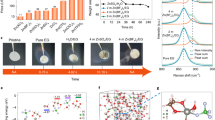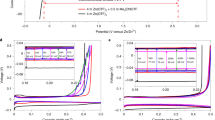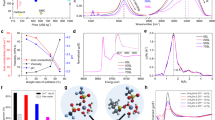Abstract
Metallic zinc (Zn) has been regarded as an ideal anode material for aqueous batteries because of its high theoretical capacity (820 mA h g–1), low potential (−0.762 V versus the standard hydrogen electrode), high abundance, low toxicity and intrinsic safety. However, aqueous Zn chemistry persistently suffers from irreversibility issues, as exemplified by its low coulombic efficiency (CE) and dendrite growth during plating/ stripping, and sustained water consumption. In this work, we demonstrate that an aqueous electrolyte based on Zn and lithium salts at high concentrations is a very effective way to address these issues. This unique electrolyte not only enables dendrite-free Zn plating/stripping at nearly 100% CE, but also retains water in the open atmosphere, which makes hermetic cell configurations optional. These merits bring unprecedented flexibility and reversibility to Zn batteries using either LiMn2O4 or O2 cathodes—the former deliver 180 W h kg–1 while retaining 80% capacity for >4,000 cycles, and the latter deliver 300 W h kg–1 (1,000 W h kg–1 based on the cathode) for >200 cycles.
This is a preview of subscription content, access via your institution
Access options
Access Nature and 54 other Nature Portfolio journals
Get Nature+, our best-value online-access subscription
$29.99 / 30 days
cancel any time
Subscribe to this journal
Receive 12 print issues and online access
$259.00 per year
only $21.58 per issue
Buy this article
- Purchase on Springer Link
- Instant access to full article PDF
Prices may be subject to local taxes which are calculated during checkout





Similar content being viewed by others
References
Kundu, D., Adams, B. D., Duffort, V., Vajargah, S. H. & Nazar, L. F. A high-capacity and long-life aqueous rechargeable zinc battery using a metal oxide intercalation cathode. Nat. Energy 1, 16119 (2016).
Pan, H. et al. Reversible aqueous zinc/manganese oxide energy storage from conversion reactions. Nat. Energy 1, 16039 (2016).
Parker, J. F. et al. Rechargeable nickel–3D zinc batteries: an energy-dense, safer alternative to lithium-ion. Science 356, 415–418 (2017).
Luo, J. Y., Cui, W. J., He, P. & Xia, Y. Y. Raising the cycling stability of aqueous lithium-ion batteries by eliminating oxygen in the electrolyte. Nat. Chem. 2, 760–765 (2010).
Yesibolati, N. et al. High performance Zn/LiFePO4 aqueous rechargeable battery for large scale applications. Electrochim. Acta. 152, 505–511 (2015).
Wu, X. et al. The electrochemical performance improvement of LiMn2O4/Zn based on zinc foil as the current collector and thiourea as an electrolyte additive. J. Power Sources 300, 453–459 (2015).
Trocoli, R. & La Mantia, F. An aqueous zinc-ion battery based on copper hexacyanoferrate. ChemSusChem. 8, 481–485 (2015).
Wang, X. et al. An aqueous rechargeable Zn//Co3O4 battery with high energy density and good cycling behavior. Adv. Mater. 28, 4904–4911 (2016).
Zhang, L., Chen, L., Zhou, X. & Liu, Z. Towards high-voltage aqueous metal-ion batteries beyond 1.5 V: the zinc/zinc hexacyanoferrate system. Adv. Energy Mater. 5, 1400930 (2015).
Liu, Z. et al. Dendrite-free nanocrystalline zinc electrodeposition from an ionic liquid containing nickel triflate for rechargeable Zn-based batteries. Angew. Chem. Int. Ed. 55, 2889–2893 (2016).
Li, Y. & Dai, H. Recent advances in zinc–air batteries. Chem. Soc. Rev. 43, 5257–5275 (2014).
Li, G., Yang, Z., Jiang, Y., Zhang, W. & Huang, Y. Hybrid aqueous battery based on Na3V2(PO4)3/C cathode and zinc anode for potential large-scale energy storage. J. Power Sources 308, 52–57 (2016).
Zhang, H., Du, Q., Li, C. & Sun, X. Binary ion batteries operating on the model of Newton’s cradle. J. Electrochem. Soc. 159, A2001–A2004 (2012).
Yan, J. et al. Rechargeable hybrid aqueous batteries. J. Power Sources 216, 222–226 (2012).
Xu, M., Ivey, D. G., Xie, Z. & Qu, W. Rechargeable Zn–air batteries: progress in electrolyte development and cell configuration advancement. J. Power Sources 283, 358–371 (2015).
Fu, J. et al. Flexible high-energy polymer-electrolyte-based rechargeable zinc–air batteries. Adv. Mater. 27, 5617–5622 (2015).
Pei, P., Wang, K. & Ma, Z. Technologies for extending zinc–air battery’s cyclelife: a review. Appl. Energy 128, 315–324 (2014).
Qian, J. et al. High rate and stable cycling of lithium metal anode. Nat. Commun. 6, 6362 (2015).
Xu, W. et al. Lithium metal anodes for rechargeable batteries. Energy Environ. Sci. 7, 513–537 (2014).
Parker, J. F. et al. Retaining the 3D framework of zinc sponge anodes upon deep discharge in Zn–air cells. ACS Appl. Mater. Interfaces 6, 19471–19476 (2014).
Parker, J. F., Chervin, C. N., Nelson, E. S., Rolison, D. R. & Long, J. W. Wiring zinc in three dimensions re-writes battery performance—dendrite-free cycling. Energy Environ. Sci. 7, 1117 (2014).
Chamoun, M. et al. Hyper-dendritic nanoporous zinc foam anodes. NPG Asia Mater. 7, e178 (2015).
Banik, S. J. & Akolkar, R. Suppressing dendrite growth during zinc electrodeposition by PEG-200 additive. J. Electrochem. Soc. 160, D519–D523 (2013).
Suo, L. et al. 'Water-in-salt' electrolyte enables high-voltage aqueous lithium-ion chemistries. Science 350, 938–943 (2015).
Guerfi, A. et al. High cycling stability of zinc-anode/conducting polymer rechargeable battery with non-aqueous electrolyte. J. Power Sources 248, 1099–1104 (2014).
Xu, M., Ivey, D. G., Xie, Z., Qu, W. & Dy, E. The state of water in 1-butyl-1-methyl-pyrrolidinium bis(trifluoromethanesulfonyl)imide and its effect on Zn/Zn(ii) redox behavior. Electrochim. Acta. 97, 289–295 (2013).
Xu, M., Ivey, D. G., Xie, Z. & Qu, W. Electrochemical behavior of Zn/Zn(ii) couples in aprotic ionic liquids based on pyrrolidinium and imidazolium cations and bis(trifluoromethanesulfonyl)imide and dicyanamide anions. Electrochim. Acta. 89, 756–762 (2013).
Xu, M. et al. Zn/Zn(ii) redox kinetics and Zn deposit morphology in water added ionic liquids with bis(trifluoromethanesulfonyl)imide anions. J. Electrochem. Soc. 161, A128–A136 (2013).
Han, S. D. et al. Origin of electrochemical, structural, and transport properties in nonaqueous zinc electrolytes. ACS Appl. Mater. Interfaces 8, 3021–3031 (2016).
Liu, Z., El Abedin, S. Z. & Endres, F. Dissolution of zinc oxide in a protic ionic liquid with the 1-methylimidazolium cation and electrodeposition of zinc from ZnO/ionic liquid and ZnO/ionic liquid–water mixtures. Electrochem. Commun. 58, 46–50 (2015).
Barnum, D. W. Hydrolysis of cations. Formation constants and standard free energies of formation of hydroxy complexes. Inorg. Chem. 22, 2297–2305 (1983).
Sze, Y.-K. & Irish, D. E. Vibrational spectral studies of ion–ion and ion–solvent interactions. I. Zinc nitrate in water. J. Solut. Chem. 7, 395–415 (1978).
Smith, G. D., Bell, R., Borodin, O. & Jaffe, R. L. A density functional theory study of the structure and energetics of zincate complexes. J. Phys. Chem. A 105, 6506–6512 (2001).
Barnum, D. W. Hydrolysis of cations—formation-constants and standard free-energies of formation of hydroxy complexes. Inorg. Chem. 22, 2297–2305 (1983).
Scatena, L., Brown, M. & Richmond, G. Water at hydrophobic surfaces: weak hydrogen bonding and strong orientation effects. Science 292, 908–912 (2001).
Borodin, O. et al. Liquid structure with nano-heterogeneity promotes cationic transport in concentrated electrolytes. ACS Nano 11, 10462–10471 (2017).
Smith, A., Burns, J. & Dahn, J. A high precision study of the Coulombic efficiency of Li-ion batteries. Electrochem. Solid State Lett. 13, A177–A179 (2010).
Burns, J. et al. Predicting and extending the lifetime of Li-ion batteries. J. Electrochem. Soc. 160, A1451–A1456 (2013).
Zhang, J. et al. Laminated cross-linked nanocellulose/graphene oxide electrolyte for flexible rechargeable zinc–air batteries. Adv. Energy Mater. 6, 1600476 (2016).
Xu, N. et al. Self-assembly formation of bi-functional Co3O4/MnO2–CNTs hybrid catalysts for achieving both high energy/power density and cyclic ability of rechargeable zinc–air battery. Sci. Rep. 6, 33590 (2016).
Suren, S. & Kheawhom, S. Development of a high energy density flexible zinc–air battery. J. Electrochem. Soc. 163, A846–A850 (2016).
Liu, X. et al. High-performance non-spinel cobalt–manganese mixed oxide-based bifunctional electrocatalysts for rechargeable zinc–air batteries. Nano Energy 20, 315–325 (2016).
Li, G. et al. Pomegranate-inspired design of highly active and durable bifunctional electrocatalysts for rechargeable metal–air batteries. Angew. Chem. Int. Ed. 55, 4977–4982 (2016).
Kar, M., Simons, T. J., Forsyth, M. & MacFarlane, D. R. Ionic liquid electrolytes as a platform for rechargeable metal–air batteries: a perspective. Phys. Chem. Chem. Phys. 16, 18658–18674 (2014).
Ho, C. C., Evans, J. W. & Wright, P. K. Direct write dispenser printing of a zinc microbattery with an ionic liquid gel electrolyte. J. Micromech. Microeng. 20, 104009 (2010).
Lu, J. et al. A lithium–oxygen battery based on lithium superoxide. Nature 529, 377–382 (2016).
Glinka, C. et al. The 30 m small-angle neutron scattering instruments at the National Institute of Standards and Technology. J. Appl. Crystallogr. 31, 430–445 (1998).
Kline, S. R. Reduction and analysis of SANS and USANS data using IGOR Pro. J. Appl. Crystallogr. 39, 895–900 (2006).
Marenich, A. V., Cramer, C. J. & Truhlar, D. G. Universal solvation model based on solute electron density and on a continuum model of the solvent defined by the bulk dielectric constant and atomic surface tensions. J. Phys. Chem. B 113, 6378–6396 (2009).
Amin, E. A. & Truhlar, D. G. Zn coordination chemistry: development of benchmark suites for geometries, dipole moments, and bond dissociation energies and their use to test and validate density functionals and molecular orbital theory. J. Chem. Theor. Comput. 4, 75–85 (2008).
Acknowledgements
The principal investigators (K.X. and C.W.) gratefully acknowledge funding support from DOE ARPA-E (DEAR0000389) and the Center of Research on Extreme Batteries. We also acknowledge the support of the Maryland Nano Center and its NispLab. NispLab is supported in part by the NSF as a MRSEC Shared Experimental Facility. O.B. acknowledges Army funding DRI16-SE-019 for modelling. F.W. was supported by the Oak Ridge Associated Universities through contract W911NF-16-2-0202.
Author information
Authors and Affiliations
Contributions
F.W., K.X. and C.W. conceived the idea and co-wrote the manuscript. O.B. conducted the MD simulations and DFT calculations. A.F. and J.A.D. conducted the SANS measurements. F.W. carried out the synthesis, material characterizations, and electrochemical evaluation. T.G., X.F., W.S. and F.H. assisted with the material characterizations.
Corresponding author
Additional information
Publisher’s note: Springer Nature remains neutral with regard to jurisdictional claims in published maps and institutional affiliations.
Supplementary information
Supplementary Information
Supplementary Tables 1–3, Supplementary Figures 1–17, Supplementary References 1–4
Rights and permissions
About this article
Cite this article
Wang, F., Borodin, O., Gao, T. et al. Highly reversible zinc metal anode for aqueous batteries. Nature Mater 17, 543–549 (2018). https://doi.org/10.1038/s41563-018-0063-z
Received:
Accepted:
Published:
Issue Date:
DOI: https://doi.org/10.1038/s41563-018-0063-z
This article is cited by
-
A weakly solvating electrolyte towards practical rechargeable aqueous zinc-ion batteries
Nature Communications (2024)
-
Two-electron redox chemistry via single-atom catalyst for reversible zinc–air batteries
Nature Sustainability (2024)
-
An extended substrate screening strategy enabling a low lattice mismatch for highly reversible zinc anodes
Nature Communications (2024)
-
Proton-selective coating enables fast-kinetics high-mass-loading cathodes for sustainable zinc batteries
Nature Communications (2024)
-
Design strategies for rechargeable aqueous metal-ion batteries
Science China Chemistry (2024)



